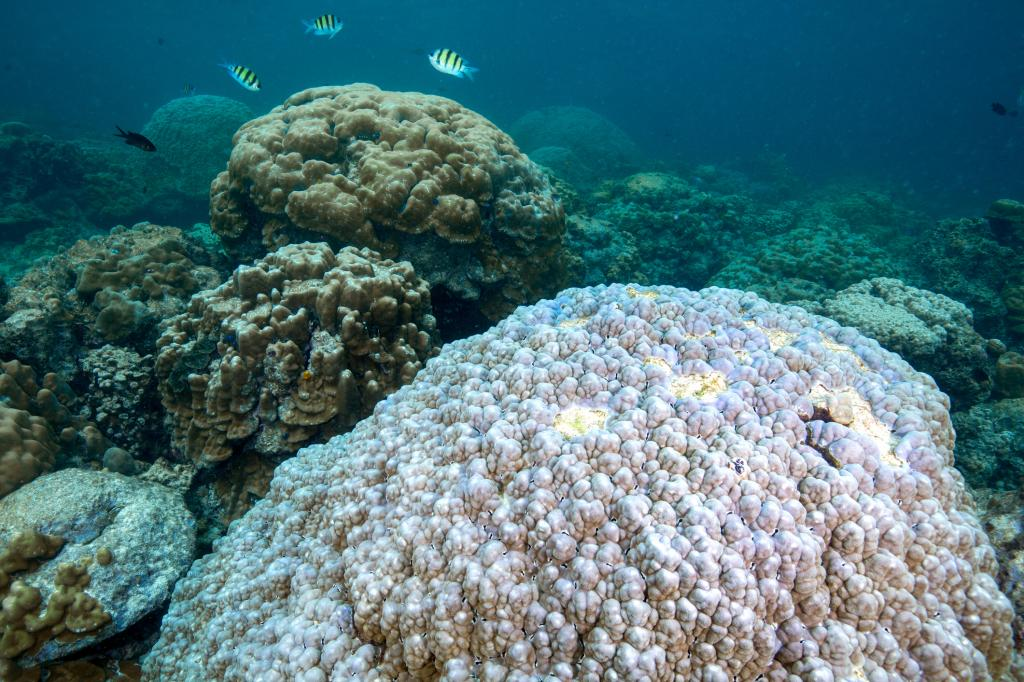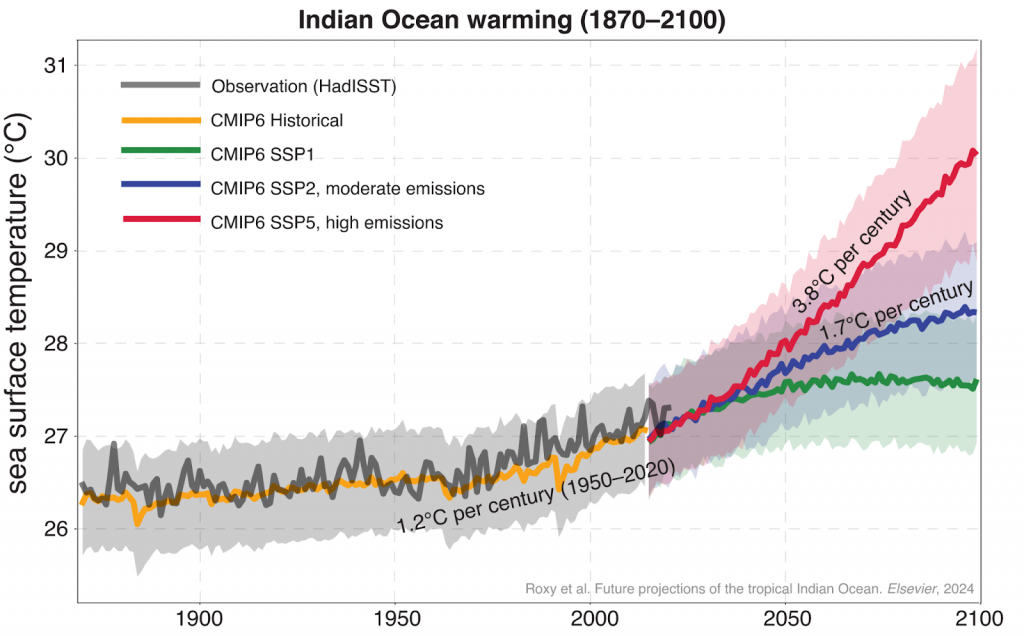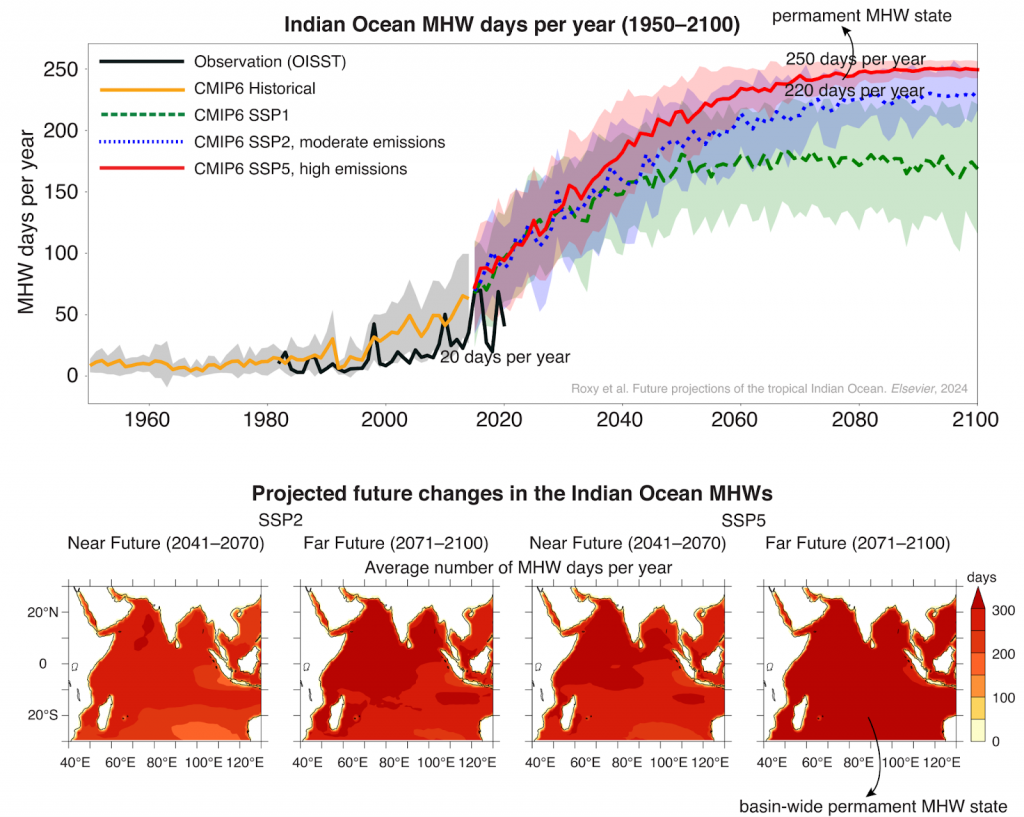Description

Disclaimer: Copyright infringement not intended.
Context:
- A new study published in the journal Science Direct has found unprecedented and accelerated warming in the Indian Ocean.
Details of the findings
- Between 2020 and 2100, the Indian Ocean could warm at a rate of 1.7-3.8 degrees Celsius per century.
- The study also examined the Indian Ocean’s warming over the past century, finding that the ocean basin heated at a rate of 1.2°C per century between 1950 and 2020.
- Between 1980 and 2020, the maximum sea surface temperatures (SST) across the Indian Ocean generally stayed below 28°C (ranging from 26-28°C).
- If GHGs are emitted at current levels, the minimum SSTs in the Indian Ocean could exceed 28°C (28.5-30.7°C) all year round by the end of the 21st century,
- Currently, the heat content of the first 2,000 meters below the ocean surface is increasing at a rate of 4.5 zettajoules per decade, with projections indicating a dramatic increase to 16-22 zettajoules per decade in the future.
- The future increase in heat content is equivalent to adding the energy of one Hiroshima atomic bomb detonation every second, all day, every day, for a decade. The northwestern parts of the Indian Ocean, including the Arabian Sea, experienced the most significant warming, while the southeastern parts of the ocean, off the coasts of Sumatra and Java, experienced the least warming.
- The number of days with marine heatwaves is expected to increase from 20 to 220-250 days a year, according to the study. This would mean that most of the Indian Ocean could be in a near-permanent state of marine heatwave conditions.
- The bio-geochemical characteristics of the Indian Ocean are also expected to change due to the warming. For instance, the pH levels of the ocean’s waters are projected to decrease from about 8.1 currently to 7.7 by the end of the century.

Impacts:
- This warming of the ocean’s surface, along with the heat accumulated in the first 2,000 meters below the surface, has significant repercussions for the southwest monsoon season, which provides about 70 percent of India’s annual rainfall and also affects rainfall patterns in other South Asian countries.
- This warming could also lead to more frequent and intense extreme weather events, such as tropical cyclones and floods, as well as a rise in sea levels due to thermal expansion.
- Generally, SSTs above 28°C are conducive to the formation of tropical cyclones and extremely heavy rainfall. Heavy rainfall events and extremely severe cyclones have already become more frequent since the 1950s and are projected to increase further with rising ocean temperatures
- The increased ocean heat would also cause thermal expansion in the Indian Ocean, resulting in rising sea levels in the 40 countries that border it. Thermal expansion of water accounts for more than half of the sea level rise in the ocean, exceeding the contribution from glaciers and sea ice melting.
- Other natural climatic phenomena, such as the Indian Ocean Dipole (IOD), are also expected to change due to the warming of the Indian Ocean. The positive and negative phases of the IOD influence rainfall during the southwest monsoon and affect the formation of tropical cyclones. The study predicted that the frequency of extreme IOD events may increase by 66 percent, while the frequency of moderate events is projected to decrease by 52 percent by the end of the century.
|
●In the positive phase of the IOD, when the western parts of the Indian Ocean are warmer than the eastern parts, monsoon rainfall generally increases across many regions in India and the rest of South Asia.
●In the negative phase, when the western parts of the ocean are cooler than the eastern parts, less than normal rainfall is observed during the post-monsoon period in northwestern India.
|

- Marine heatwaves lead to habitat destruction through coral bleaching, seagrass loss and the degradation of kelp forests, adversely affecting the fisheries sector. They also result in the rapid intensification of cyclones, where a cyclone can intensify from a depression to a severe category within a few hours.
- The projected changes in pH may be detrimental to the marine ecosystem since many marine organisms — particularly corals and organisms that depend on calcification to build and maintain their shells — are sensitive to the change in ocean acidity. The change in pH can result in rather profound health consequences and multiple-organ failure.
- The productivity and surface levels of chlorophyll are also expected to decline by 2100, with the greatest reduction in the western Arabian Sea, where levels could fall by 8-10 per cent from their current state.
Conclusion:
- A multifaceted approach to address the imminent challenges in the Indian Ocean. Reducing GHG emissions and building climate-resilient infrastructure are the most effective strategies to mitigate the current and future impacts of warming.
- Concurrently, conserving marine ecosystems through sustainable practices and improving forecasting capabilities can strengthen the region’s resilience to extreme weather events. Additionally, promoting adaptive agriculture and encouraging international collaboration are essential for ensuring food security and preserving biodiversity, according to the study.
Marine Heatwaves details:
https://www.iasgyan.in/daily-current-affairs/marine-heatwaves
Source:
https://www.downtoearth.org.in/news/climate-change/indian-ocean-is-heating-up-much-faster-than-we-think-at-a-rate-of-1-7-3-8-c-per-century-95871
|
PRACTICE QUESTION
Q) Discuss the findings of the recent study published in Science Direct regarding the unprecedented and accelerated warming trends in the Indian Ocean. Evaluate the potential impacts of this warming on regional climate patterns, extreme weather events, marine ecosystems, and socio-economic factors. (250 words)
|














